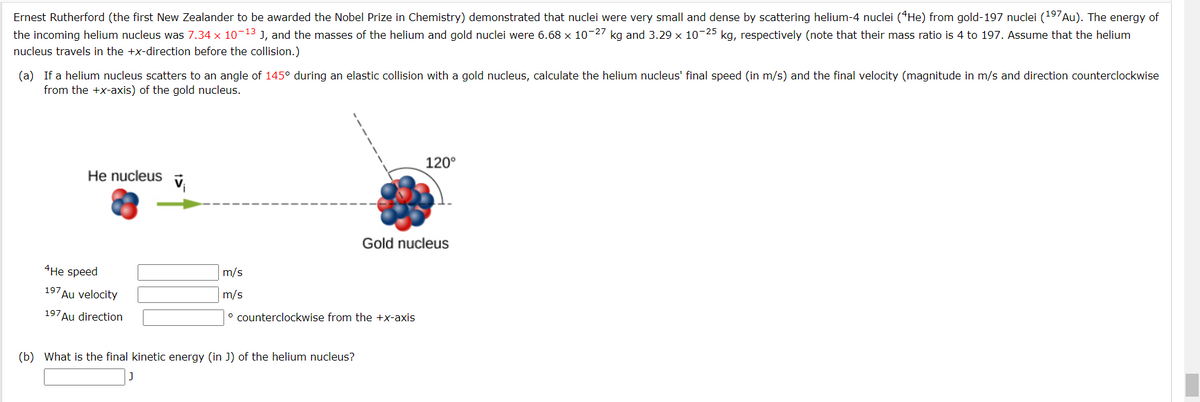Ernest Rutherford (the first New Zealander to be awarded the Nobel Prize in Chemistry) demonstrated that nuclei were very small and dense by scattering helium-4 nuclei (He) from gold-197 nuclei (197 Au). The energy of the incoming helium nucleus was 7.34 x 10-13 J, and the masses of the helium and gold nuclei were 6.68 x 10-27 kg and 3.29 x 10-25 kg, respectively (note that their mass ratio is 4 to 197. Assume that the helium nucleus travels in the +x-direction before the collision.) (a) If a helium nucleus scatters to an angle of 145° during an elastic collision with a gold nucleus, calculate the helium nucleus' final speed (in m/s) and the final velocity (magnitude in m/s and direction counterclockwise from the +x-axis) of the gold nucleus. He nucleus v₁ 4He speed 197 Au velocity 197 Au direction m/s m/s 120° Gold nucleus counterclockwise from the +x-axis
Ernest Rutherford (the first New Zealander to be awarded the Nobel Prize in Chemistry) demonstrated that nuclei were very small and dense by scattering helium-4 nuclei (He) from gold-197 nuclei (197 Au). The energy of the incoming helium nucleus was 7.34 x 10-13 J, and the masses of the helium and gold nuclei were 6.68 x 10-27 kg and 3.29 x 10-25 kg, respectively (note that their mass ratio is 4 to 197. Assume that the helium nucleus travels in the +x-direction before the collision.) (a) If a helium nucleus scatters to an angle of 145° during an elastic collision with a gold nucleus, calculate the helium nucleus' final speed (in m/s) and the final velocity (magnitude in m/s and direction counterclockwise from the +x-axis) of the gold nucleus. He nucleus v₁ 4He speed 197 Au velocity 197 Au direction m/s m/s 120° Gold nucleus counterclockwise from the +x-axis
Related questions
Question

Transcribed Image Text:Ernest Rutherford (the first New Zealander to be awarded the Nobel Prize in Chemistry) demonstrated that nuclei were very small and dense by scattering helium-4 nuclei (He) from gold-197 nuclei (197Au). The energy of
the incoming helium nucleus was 7.34 x 10-13 J, and the masses of the helium and gold nuclei were 6.68 x 10-27 kg and 3.29 × 10-25 kg, respectively (note that their mass ratio is 4 to 197. Assume that the helium
nucleus travels in the +x-direction before the collision.)
(a) If a helium nucleus scatters to an angle of 145° during an elastic collision with a gold nucleus, calculate the helium nucleus' final speed (in m/s) and the final velocity (magnitude in m/s and direction counterclockwise
from the +x-axis) of the gold nucleus.
He nucleus
4He speed
197
Au velocity
197 Au direction
m/s
m/s
° counterclockwise from the +x-axis
(b) What is the final kinetic energy (in J) of the helium nucleus?
120°
Gold nucleus
Expert Solution
This question has been solved!
Explore an expertly crafted, step-by-step solution for a thorough understanding of key concepts.
This is a popular solution!
Trending now
This is a popular solution!
Step by step
Solved in 3 steps
